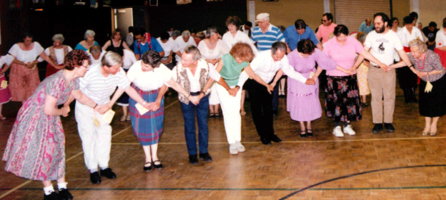
|
Folk Dance Federation of California, South, Inc.
Chain Dance Positions
Compiled by Dick Oakes
|

|
CLICK IMAGE TO ENLARGE
A "chain" dance is a form in which dancers stand in a line, semi-circle, or circle and
are joined by holding hands or belts with the person on either side.
The hand hold may vary (low, elbows bent, elbows straight, elbow hold, shoulder hold,
belt hold, front basket, back basket, et cetera).
The following are but a sample of the many chain dance positions used in folk dancing.
A
Hand on own hip with elbow turned outward; called "akimbo." Often used to mean both hands in this pos.
B
Hands joined with second person on either side in a "Back Basket" hold. When the cir alternates exactly M, W, M, W, etc., W hands tend to be joined over M arms to allow the M to give better support. Also known as a "back chair" pos.
F
Hands joined with second person on either side in a "Front Basket" hold. If the dance moves predominantly to the L, L arm is under. Elbows are not locked, but rather are held with a "dancer's tension" so that the line may expand and contract with the natural movements of the dance. (Depending on the dance requirements, middle fingers may be held in what is called "Slavonian pos.")
L
Hands clasped with dancers on either side, R hand with palm fwd, R shldr slightly behind the shldr of the dancer to the R, elbows bent in right angle and held tightly to sides. (Depending on the requrements of the dance, fingers may be interlaced.)
Q
Hand on hip ("akimbo") with other hand through elbow of next dancer in line as if being "escorted." The hand through the elbow looks relaxed with wrist over forearm of that person, but has a "dancer's tension," so that the line may slightly expand and contract with the natural movements of the dance. (Also known as "Escort" or "Teacup" position.)
T
Hand extended out to side, firmly (but not strongly) grasping shldr of next dancer in line. If line moves predominantly to R, R arm is under. Elbows, rather than locked, are held with a "dancer's tension" so that the line may expand and contract slightly with the natural movements of the dance. This prevents the awkward and sometimes painful situation where the next dancer receives a "straight arm," football style, to the side of the neck!
V
Hand joined with the next dancer and extended down between you and that dancer.
W
Hand joined with next dancer and held comfortably at shoulder level between you and that dancer. Hands are usually held slightly fwd of shldrs. Depending on the requrements of the dance, hands may be held forward of shldrs, arms rounded, or held back close to shldrs. Also, again depending on the requirements of the dance, little fingers may be held ("Little Finger Hold") or fingers may be interlaced.
X
Hold next dancer's belt halfway between hip and navel ("Belt Hold"). If the dance moves predominantly to the R, R arm is under. Elbows are not locked, but rather are held with a "dancer's tension" so that the line may expand and contract with the natural movements of the dance. May also be held behind neighbor's back depending on the dance.
Y
Hand joined with that of the next dancer in line and extended upward high between you and that dancer.

